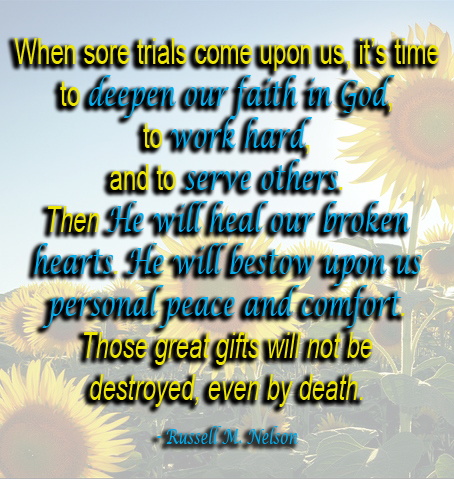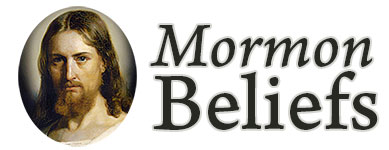The writer of Ecclesiastes said, “To everything there is a season, and a time to every purpose under heaven: A time to be born, and a time to die; … a time to weep, and a time to laugh; a time to mourn and a time to dance” (Ecclesiastes 3:1-2, 4). This scripture seems most poignant when a loved one dies. Death is part of life, but for members of The
 Church of Jesus Christ of Latter-day Saints—sometimes inadvertently called the Mormon Church—it is a new beginning, not an end. Elder Russell M. Nelson, an apostle of the Lord Jesus Christ), said:
Church of Jesus Christ of Latter-day Saints—sometimes inadvertently called the Mormon Church—it is a new beginning, not an end. Elder Russell M. Nelson, an apostle of the Lord Jesus Christ), said:
Life does not begin with birth, nor does it end with death. Prior to our birth, we dwelled as spirit children with our Father in Heaven. There we eagerly anticipated the possibility of coming to earth and obtaining a physical body. Knowingly we wanted the risks of mortality, which would allow the exercise of agency and accountability. This life [was to become] a probationary state; a time to prepare to meet God’ (Alma 12:24 in the Book of Mormon, another testament of Jesus Christ and a companion scripture to the Bible). But we regarded the returning home as the best part of that long-awaited trip, just as we do now. Before embarking on any journey, we like to have some assurance of a round-trip ticket. Returning from earth to life in our heavenly home requires passage through—and not around—the doors of death. We were born to die, and we die to live. [1]
‘O Death, Where is Thy Sting?’
The Apostle Paul said to the Corinthians, in 1 Corinthians 15:55, “O death, where is thy sting? O grave, where is thy victory?” For those who are left behind, the death of a loved one can seem so heartbreakingly final. But the scriptures teach us otherwise. President Thomas S. Monson, prophet and president of The Church of Jesus Christ, said:
We laugh, we cry, we work, we play, we love, we live. And then we die. Death is our universal heritage. All must pass its portals. Death claims the aged, the weary and worn. It visits the youth in the bloom of hope and the glory of expectation. Nor are little children kept beyond its grasp. In the words of the Apostle Paul, “It is appointed unto men once to die” (Hebrews 9:27). And dead we would remain but for one Man and His mission, even Jesus of Nazareth. Born in a stable, cradled in a manger, His birth fulfilled the inspired pronouncements of many prophets. He was taught from on high. He provided the life, the light, and the way. Multitudes followed Him. Children adored Him. The haughty rejected Him. He spoke in parables. He taught by example. He lived a perfect life. … To all who have lost loved ones, we would … answer: If a man die, he shall live again. We know, for we have the light of revealed truth. “I am the resurrection, and the life,” spoke the Master. “He that believeth in me, though he were dead, yet shall he live: And whosoever liveth and believeth in me shall never die” (John 11:25–26). Through tears and trials, through fears and sorrows, through the heartache and loneliness of losing loved ones, there is assurance that life is everlasting. Our Lord and Savior is the living witness that such is so. [2]
The Savior, through His infinite Atonement, has taken the sting out of death. We will all die, but we will all live again through the loving sacrifice of our Savior and Redeemer, Jesus Christ.
Death is Not the End
The late President Gordon B. Hinckley, the past president of The Church of Jesus Christ, said:
Death is not final. Though it seems so when its dark shroud overshadows mortal life, to those who accept the Christ and His eternal mission there is light and comfort, there is assurance, there is certainty. …Of all the victories in human history, none is so great, none so universal in its effect, none so everlasting in its consequences as the victory of the crucified Lord who came forth in the Resurrection that first Easter morning. [3]
Elder Lance B. Wickman, a member of the Quorum of the Seventy (Seventies, just as in New Testament times, are called to proclaim the gospel and build up The Church of Jesus Christ), said:
Grief is the natural by-product of love. One cannot selflessly love another person and not grieve at his suffering or eventual death. The only way to avoid the grief would be to not experience the love; and it is love that gives life its richness and meaning. [4]
And, as Elder Nelson so beautifully said:
We can’t fully appreciate joyful reunions later without tearful separations now. The only way to take sorrow out of death is to take love out of life. …Our limited perspective would be enlarged if we could witness the reunion on the other side of the veil, when doors of death open to those returning home. Such was the vision of the psalmist who wrote, ‘Precious in the sight of the Lord is the death of his saints’ (Psalms 116:15). [1]
For these reasons, Mormon funerals are very hopeful and inspiring. Loved ones grieve because of the separation from the deceased for a season, and for missed opportunities on earth, perhaps, but not out of despair. We know where we are going and rejoice in the promise of a future joyous reunion with our loved ones and the knowledge that separation need never be endured again. We can’t fully appreciate and understand joy without sorrow, love without loss. They make life sweeter and more meaningful. Knowing that life does not end at death, we need not fear it. Understanding the purpose of life allows us to more fully appreciate the gift that it is. May we live our lives to be able to say, as the Apostle Paul, “The time of my departure is at hand. I have fought a good fight, I have finished my course, I have kept the faith” (2 Timothy 4:6–7). Watch the Funeral of Frances Monson, beloved departed wife of Prophet Thomas S. Monson.
